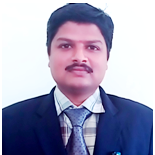
Sunil S Harakannanavar
Work place: Department of Electronics and Communication Engineering, S G Balekundri Institute of Technology, Belagavi, India
E-mail: sunilsh143@gmail.com
Website:
Research Interests: Computer systems and computational processes, Computer Vision, Pattern Recognition, Computer Graphics and Visualization
Biography
Mr. Sunil S Harakannanavar completed his Bachelor of Engineering in the stream of Electronics & Communication from Sri Taralabalu Jagadguru Institute of Technology, Ranebennur and his masters in the field of Microelectronics and Control Systems from Nitte Mahalinga Adyanthaya Memorial Institute of Technology, Nitte. Presently he is working as Assistant Professor with S. G. Balekundri Institute of Technology Belagavi. He is pursuing his Ph.D at Visvesvaraya Technological University, Belagavi and his area of interests includes Computer Vision, Pattern Recognition and Biometrics. He is a life member of Indian Society for Technical Education, New Delhi and Institute for Exploring Advances in Engineering.
Author Articles
An Extensive Review of Feature Extraction Techniques, Challenges and Trends in Automatic Speech Recognition
By Vidyashree Kanabur Sunil S Harakannanavar Dattaprasad Torse
DOI: https://doi.org/10.5815/ijigsp.2019.05.01, Pub. Date: 8 May 2019
Speech is the natural mode of communication between humans. Human-to-machine interaction is gaining importance in the past few decades which demands the machine to be able to analyze, respond and perform tasks at the same speed as performed by human. This task is achieved by Automatic Speech Recognition (ASR) system which is typically a speech-to-text converter. In order to recognize the areas of further research in ASR, one must be aware of the current approaches, challenges faced by each and issues that needs to be addressed. Therefore, in this paper human speech production mechanism is discussed. The various speech recognition techniques and models are addressed in detail. The performance parameters that measure the accuracy of the system in recognizing the speech signal are described.
[...] Read more.Comprehensive Study of Data Aggregation Models, Challenges and Security Issues in Wireless Sensor Networks
By Veena I Puranikmath Sunil S Harakannanavar Satyendra Kumar Dattaprasad Torse
DOI: https://doi.org/10.5815/ijcnis.2019.03.05, Pub. Date: 8 Mar. 2019
The use of wireless sensor networks has been increasing tremendously in the past decades mainly because of its applications in military, medicine, under water survey and various other fields. Depending on the applications the sensor nodes are placed in different areas and the data sensed will be sent to the base station. The process of transmitting and receiving data sensed by the sensor nodes continues till the sensors have battery life. This leads to generate data redundancy and reduces efficiency of the network. In order to overcome the limitations faced by the wireless sensor networks, the fusion of data known as data aggregation is introduced. In data aggregation, the data sensed by the various nodes are aggregated and sent to the base station as a single data packet. In this paper, a brief review on various data aggregation methods, challenges and issues are addressed. In addition to this, performance parameters of various data fusion methods to measure the efficiency of the network are discussed. The design of single aggregator models are easy compared to the multiple aggregator models. However, the security to most of the data fusion schemes is provided by using message authentication code. It also uses public keys and symmetric to achieve end to end or hop by hop encryptions.
[...] Read more.Other Articles
Subscribe to receive issue release notifications and newsletters from MECS Press journals